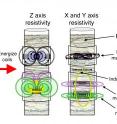Noninvasive probing of geological core samples
Oil and natural gas companies rely upon geological core analyses to help them understand and evaluate oil and gas reserves. A rock sample can reveal myriad details about a geological structure's formation, content, and history. Conductivity, a material's ability to carry an electrical current, is one of the most useful measurements of core samples. The conductivity of a geological formation depends on the direction of measurement, so it's considered "anisotropic."
"Anisotropy is usually the result of many thin layers of oil-bearing sandstone rocks sandwiched between thin shale layers, which form a laminate structure that may be tens to thousands of feet thick and contain a large amount of oil," explains John Kickhofel, a research scientist. In anisotropic layers of the Earth, the conductivity in one direction is different from that of others.
Tools to measure a core sample's electrical anisotropy have been sadly lacking, says Kickhofel. To solve this problem, he and colleagues at the company Schlumberger found inspiration in a type of logging technology currently used by the modern oil industry. They created a device capable of noninvasively measuring electrical conductivity -- a device they describe in the journal Review of Scientific Instruments, which is published by the American Institute of Physics.
"We designed a probe that uses a core from the formations and measures its electrical anisotropy without destroying the core," Kickhofel says. "This device can make continuous measurements on cores that are hundreds or thousands of feet long."
Cores are valuable because they provide firsthand information about the structure and nature of rock layers and need to be preserved for future reference. "It's very important to preserve the cores, and the new device provides a way to do this. We can't overstate the value of such a measurement to the oil industry in an era when most fields are in decline -- yet the world's demand for oil and gas continues to skyrocket," adds Kickhofel.
Source: American Institute of Physics
Other sources
- Noninvasive probing of geological core samplesfrom Science DailyThu, 15 Jul 2010, 6:21:19 UTC
- Noninvasive probing of geological core samplesfrom PhysorgWed, 14 Jul 2010, 13:49:15 UTC
- Noninvasive Probing of Geological Core Samplesfrom Newswise - ScinewsTue, 13 Jul 2010, 21:42:17 UTC
